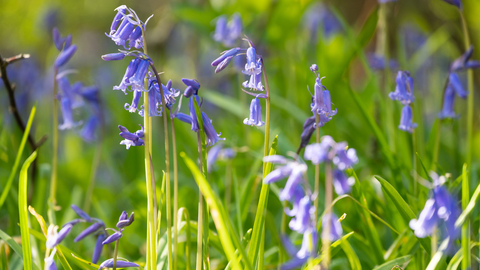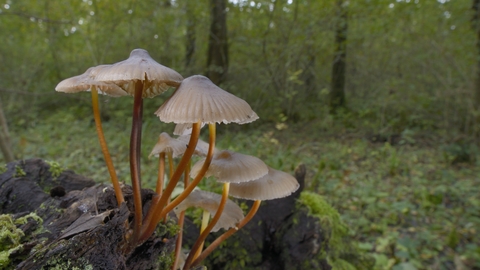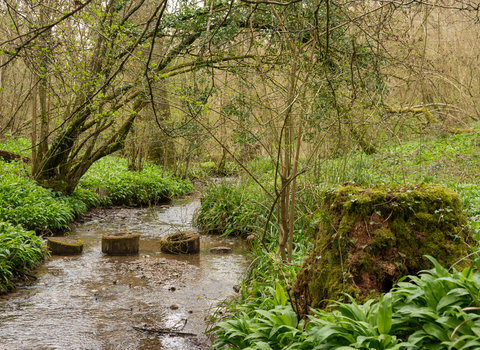
Lower Woods (c) Nathan Millar

Lower Woods (c) Nathan Millar

Lower Woods (c) Nathan Millar

Clustered bonnet fungi at Lower Woods (c) Nick Upton
Location
Know before you go
Dogs
We ask dog owners to note that this is access land and this means that dogs must be kept on short leads (2 metres or less) between 1st March and 31st July (as stated in the Countryside and Rights of Way Act 2000).
When to visit
Opening times
Open access throughout the yearBest time to visit
Throughout the yearAbout the reserve
At almost 300 hectares, Lower Woods is the largest ancient woodlands in the southwest, perfect for exploring and immersing yourself in nature.
Lower Woods is jointly managed with Avon Wildlife Trust and is famous for its butterflies with 32 reported species being found here, in particular silver-washed fritillary, white-letter hairstreak and white admirals.
While patches of Lower Woods were planted up in the 1950s and 1960s with non-native softwood trees like western red cedar and Norway spruce, naturally it was a broad-leaved deciduous woodland with native trees like oaks, ash and hazel. Small-leaved limes and wayfaring trees can also be found here, along with wild service trees that develop fruits called chequers which litter the floor in autumn.
There are small wildflower-rich meadows and open banks, with the Little Avon River flowing through the reserve and into the River Severn. The rich woodland flowers and plants here include carpets of bluebells in spring, early purple orchids, greater butterfly orchids and herb Paris. In the summer look for old meadow species including ragged-robin, common-spotted orchids, betony and devil’s-bit scabious.
Standing deadwood can also be found throughout the woodland, which is a very important habitat for insects and invertebrates.
The traditional woodland management technique of coppicing, which has been carried out over the centuries at Lower Woods, meant trees of varying ages were found throughout, so there was always somewhere suitable from lots of different species of plants, fungi, invertebrates and birds. Traditionally it was well known for nightingale and was the most westerly part of the country to find them. The abandonment of coppicing made Lower Woods meant that species like the nightingale were lost, but the reintroduction of this management practice by GWT has resulted in many species making a comeback, including the elusive marsh fritillary butterfly.
Abraham’s walk is a large open glade that is known locally as Adder Bank, as it was always a good spot for adders to bask in the sunshine. Over the years, trees reclaimed the glade and reduced adder numbers. Work carried out by staff and volunteers over the past few years has opened this area back up to encourage the species to return.
Species
Environmental designation
More detailed directions
Lower Woods can be quite difficult for your first visit, but we've put together some directions to help you on your way.
The rough track into the woods is not owned by GWT and can be rough and bumpy in places, but it is worth the journey to reach the reserve.
From M5 J14 via Wickwar
- Head south-east on B4509 towards Tortworth and Charfield - 1.9 mi
- At the roundabout turn right onto B4058 - 0.4 mi
- Take the first left onto B4509 and The Downs to Wickwar - 2 mi
- At the traffic lights turn left onto Station Road 0.2 miles
- Take right onto narrow Chase Lane, signed to Inglestone Common and Hawkesbury 1.7 miles
- On Inglestone Common look for where two tracks form a crossroads with the road at Inglestone Farm and take the track opposite into Lower Woods 0.5 miles.
From A46 / Hawkesbury
- Just south of the A46/A433 Dunkirk junction turn west signed to Hawksbury Upton and Hillesley.
- Go through Hawkesbury Upton staying on France Ln / Sandpits Ln / High St - 1.6 miles
- As you leave the village look for a very tall Monument ahead.
- After Hawkesbury there is a slight left bend, the monument is on the right go down the single track lane on the left, opposite the monument - 0.6 mi
- At the junction with the phone box, keep right over the cattle grid - 1.0 mi
- On Inglestone Common look for where two tracks form a crossroads with the road at Inglestone Farm and take the track opposite into Lower Woods 0.5 miles. Dead slow!
Ash dieback
Ash trees in Lower Woods have been affected by a fungal disease called Ash-dieback. There is a risk infected ash tree's limbs will become brittle and break, falling onto walkways. GWT puts visitor safety first and we are taking pre-emptive action to avoid any risks to visitors. Please take care when walking through the wood and please bear with us as we work to make the woods as safe as possible.
Ash dieback (Hymenoscyphus fraxineus) is a fungus which originated in Asia, and while it doesn’t cause much damage to the ash in its native range, its introduction to Europe about 30 years ago has been devastating on our native European ash species with a fatality rate of 70-85% over a 20-year period. They didn’t evolve with the fungus, and therefore have no natural defence against it.
Ash is a common and important tree in woodlands, open habitat and hedgerows, and is a frequent early coloniser of open land, meaning that you’ll see ash saplings appearing long before any other kind of tree. Ash allows a significant amount of light to reach the woodland floor, resulting in a wide variety of woodland wildflowers and plants. Ash dieback has huge implications for wildlife, with over 1,000 species relying on ash trees as their core habitat and 50% of species that rely on ash are at risk of extinction within 50 to 100 years.
Unfortunately, at present there is no way to eradicate this disease and there is little that can be done to prevent its spread.
At GWT, we monitor infected trees, fell those that pose any dangers to visitors, volunteers or staff, but where appropriate we allow deadwood to remain and for the new open habitats to be created, such as when the trees die or fall. A number of species associated with deadwood habitats may thrive for a short period in the conditions created by ash dieback.
There is a continued effort to monitor and identify trees that seem to show resistance to the disease, and we are encouraging natural regeneration from these individuals.
We continue to look at potential tree species that could be a suitable replacement for ash and will look to introduce them where needed.
What is coppicing?
Coppicing is a traditional method dating back many centuries, through which trees are cut back to ground level every couple of years or so, then allowed to regrow. This creates a sustainable supply of timber and has many benefits over replanting, one of which being that the felled trees have already developed robust root systems, making their regrowth faster.
Trees naturally shed their branches to extend their lifespan, so coppicing can be a good way of mimicking this process, increasing the health of the tree.
Traditionally, the harvested wood was used for all manner of things, from cladding buildings to creating walkways. A popular use of the coppiced material was for hedge laying, a traditional way of stock proofing fields.
Coppicing is also beneficial to the wildlife found in woodlands. It leads to trees of varying ages being found throughout, so there is a mixture of suitable habitats to support a wide variety of species – from birds to butterflies. As coppicing is a form of tree thinning, it also enables sunlight to reach the woodland floor, creating the perfect conditions for many wildflowers, plants and invertebrates to thrive.
The impact of this traditional woodland management method falling out of use can be worrying. Nightingale numbers are declining across the UK, and this is because coppiced woodland is their favoured habitat. The reintroduction of regular coppicing at nature reserves like Lower Woods has led to birds such as spotted flycatchers returning to the newly opened-up areas, and other birds like dippers and kingfisher have been seen along the river edges where coppicing has taken place. It also inevitably leads to more light flooding the woodland floor, which encourages a more diverse range of plants to grow. The increase of plant diversity and flower abundance then acts as an important food source for butterflies and other insects, in turn supporting birds, bats, and mammals.
The history of Lower Woods
While the term ancient woodland is used to describe woodlands that have existed since 1600CE, Lower Woods far predates that, with evidence of a Roman villa behind the lodge and human occupation for millennia.
It was traditionally a coppiced woodland, with the harvested materials being used for all manner of things from cladding, to building and fencing, a real resource to the people in the local area. While it is a tranquil place nowadays, it would have once been alive with local people caring for this valuable resource and grazing animals.
The boundaries of the 23 individual woodlands that make up Lower Woods have remained unchanged for centuries; indeed, some sections reflect the landscape as it would have looked during Medieval times.
Many of the weird and wonderful names of these old woods are still known, such as ‘South Moons Rising’ and ‘The Grubbins’. Separating the woodlands are old grassy roads called ‘trenches’ and coppices are fingers of grazed common land, on which there are cattle between May and October.
The woodland was also used for firewood and charcoal production, which continues to this day.
Future plans
Coppicing features heavily in the future of Lower Woods, with certain areas being coppiced on a 7-year rotation. Coppicing is useful in enhancing rides and glades, while halo-releasing of oaks and other native trees is taking place to allow them to re-establish. Halo-releasing involves making space around an older tree so it can receive more light, and thus live longer.
The reintroduction of coppicing has led to birds such as spotted flycatchers returning to the open areas that have been cleared, as well as dippers and kingfishers being spotted along the river since the edges have been opened up.
Our past work
Better for birds
Despite being home to over 2,500 species, from dormice to 57 types of birds, the woodland’s wildlife has been suffering in recent years. Many species of bird that call the woods home rely on the actions of humans, and the decline of traditional woodland management practices like coppicing over the last century has led to a fall in numbers.
Now, thanks to a recent project, work has been completed to help tackle the threat of wildlife losses and return areas of the woodland to their former glory.
Discover how ancient techniques are restoring the woodland
Release the titans
Magnificent oak trees in Lower Woods had been struggling to meet their full potential due to being hemmed in by plantation trees, however, thanks to recent strategic tree felling, these ancient oaks have been ‘released’ and can now flourish to support a wide range of wildlife.
By opening up the area the native oak trees can begin to re-establish and get a foothold. These oaks can then support a vast array of local wildlife - from beetles, butterflies to badgers.
Visit Lower Woods (https://youtu.be/GTl27mYHXRU)
James Stevens



